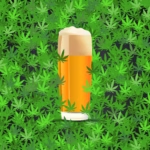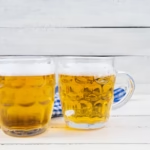Master home brewing high-alcohol craft beer with our hilarious guide! Learn legal tips to boost your beer’s ABV, from yeast tricks to sugar hacks, then explore pro brews on our brewery directory.
Home brewing high-alcohol craft beer is the ultimate brewer’s quest: transforming your garage into a laboratory for boozy, flavor-packed beers that could make a pirate salute you. Want a stout that hits like a caffeine bomb or an IPA with more punch than a karaoke night gone wild? No need for shady stills or moonshine dreams—legal home brewing techniques can push your beer’s ABV to 10% or higher. This guide, brewed fresh for July 2025, spills the hops on how to create home brewing high-alcohol craft beer without landing in legal trouble. Ready to sip pro-level high-ABV beers instead? Check out yourbrewerydirectory.com (replace with your site’s URL) for craft breweries near you. Let’s dive into home brewing high-alcohol craft beer and concoct some legal liquid magic!
Step 1: Craft a High-Gravity Recipe for High-ABV Glory
- What You Need: A recipe built for home brewing high-alcohol craft beer, like an imperial stout, barleywine, or Belgian tripel. Use 12–16 lbs of malted barley for a 5-gallon batch to create a sugar-rich wort. For example, a barleywine might combine 14 lbs of pale malt and 1 lb of caramel malt for bold flavor.
- Funny Tip: Your wort’s like a buffet for yeast—pile on the sugars, but don’t let it turn into a sticky fiasco like that time you “helped” with your kid’s pancake syrup experiment.
- Why It Matters: More malt equals more fermentable sugars, which yeast turns into alcohol. Aim for an original gravity (OG) of 1.080–1.120 (check with a hydrometer) to hit 8–12% ABV in your home brewing high-alcohol craft beer.
Step 2: Choose a Yeast That Laughs at High ABV
- What You Need: High-alcohol-tolerant yeast strains, like White Labs WLP099 (Super High Gravity Ale, up to 25% ABV) or Wyeast 3787 (Trappist High Gravity, 8–12% ABV). Pitch 2–3 times the usual amount (e.g., two liquid yeast vials or three dry yeast packets for 5 gallons).
- Funny Tip: Your yeast is like a bodybuilder on a juice cleanse—give it the good stuff, or it’ll wimp out faster than you at a hot wings challenge. Skimp, and your home brewing high-alcohol craft beer dreams crash.
- Why It Matters: Standard yeasts tap out at 8% ABV, leaving a sweet, flat beer. High-tolerance yeasts keep chugging, boosting ABV while keeping your home brewing high-alcohol craft beer tasty.
Step 3: Boost ABV with Extra Sugars
- What You Do: Add fermentable sugars like honey, maple syrup, or corn sugar (dextrose) to supercharge your home brewing high-alcohol craft beer. For a 5-gallon batch, 1–2 lbs of sugar can add 2–4% ABV. Dissolve in water, boil briefly, and add during primary fermentation.
- Funny Tip: Sugar’s your beer’s energy shot—give it a boost, but don’t go full candy store, or your brew will taste like a melted popsicle left in a gym bag.
- Why It Matters: Sugars increase fermentable content, raising ABV. Use sparingly to avoid a thin, boozy taste. Check final gravity (FG) with a hydrometer (aim for 1.010–1.020) to confirm your home brewing high-alcohol craft beer is done.
Step 4: Oxygenate and Nourish Your Yeast
- What You Do: Aerate your wort before pitching yeast (use an oxygenation wand or shake the fermenter like you’re mixing a cocktail for a giant). Add yeast nutrient (e.g., Fermaid K, 1 tsp per gallon) at the start and 24 hours into fermentation to keep yeast thriving.
- Funny Tip: Treat your yeast like a diva pop star—oxygen, nutrients, and a cozy fermenter, or it’ll throw a fit and ruin your home brewing high-alcohol craft beer. No one wants a yeast meltdown.
- Why It Matters: High-ABV fermentation stresses yeast, so oxygen and nutrients prevent stalling. Keep fermentation temps (e.g., 68–72°F for ales) to avoid off-flavors like fusel alcohols (think paint thinner vibes).
Step 5: Ferment Long and Steady
- What You Do: Ferment for 2–4 weeks in a primary fermenter, then transfer to a secondary for 1–3 months to smooth flavors. Use a conical fermenter or carboy at 68–75°F. Bottle or keg when FG stabilizes (check twice, 3 days apart).
- Funny Tip: Patience is key, unless you want a beer that tastes like it’s still sulking from being brewed. Let it chill like a cat napping in a sunbeam, and your home brewing high-alcohol craft beer will shine.
- Why It Matters: High-ABV beers need time to mellow harsh alcohol notes. Long fermentation ensures all sugars are converted, hitting that 10–15% ABV for your home brewing high-alcohol craft beer.
Step 6: Bottle or Keg with Epic Flair
- What You Do: Carbonate to style (e.g., 2.0–2.5 volumes CO2 for stouts, 2.5–3.0 for Belgian tripels). Use heavy-duty bottles (like champagne bottles) to handle pressure, and add priming sugar (e.g., 3–4 oz for 5 gallons) for bottle conditioning. Age 3–6 months for peak flavor.
- Funny Tip: Label your bottles “Thunder Stout” or “Buzzsaw Tripel” to flex at your next BBQ. If they explode from over-carbonation, maybe don’t invite your neighbor to the tasting party.
- Why It Matters: High-ABV beers carbonate slowly and can build pressure, so use sturdy bottles and measure priming sugar carefully to avoid bottle bombs in your home brewing high-alcohol craft beer adventure.
High-ABV Heroes to Spark Your Inspiration
Want pro-level home brewing high-alcohol craft beer vibes? Check out these breweries killing it:
- Dogfish Head (Milton, DE, 6 Cannery Village Center, Milton, DE 19968): Their 120 Minute IPA (15–20% ABV) uses massive malt and continuous hopping. Mimic it with 16 lbs of malt and WLP099 yeast.
- The Bruery (Placentia, CA, 717 Dunn Way, Placentia, CA 92870): Black Tuesday imperial stout (19.5% ABV) rocks Belgian candy sugar for a boozy, chocolatey punch.
- Avery Brewing (Boulder, CO, 4910 Nautilus Ct N, Boulder, CO 80301): Mephistopheles’ Stout (14.6% ABV) blends roasted malt and molasses for a devilish kick.
Keep It Legal, Keep It Safe
Home brewing high-alcohol craft beer is legal in the U.S. (up to 200 gallons per household annually, per 27 CFR § 24.152), but always sanitize equipment (use Star San) and monitor fermentation to avoid off-flavors like fusel alcohols. If your beer tastes like nail polish, toss it and try again. High-ABV brewing is safe with proper care, so double-check your measurements and keep your fermenter clean. For pro-level high-ABV beers without the effort, visit yourbrewerydirectory.com to find craft breweries serving imperial stouts or barleywines.
Plan Your High-ABV Beer Quest in July 2025
Craving home brewing high-alcohol craft beer or ready to taste the pros’ versions? In July 2025, hit taprooms like Anheuser-Busch (1 Busch Pl, St. Louis, MO 63118) for their Budweiser Reserve series or Molson Coors (3939 W Highland Blvd, Milwaukee, WI 53208) for experimental high-ABV brews. Use yourbrewerydirectory.com to discover local breweries, and check brewersassociation.org or eventbrite.com for beer festivals showcasing high-ABV beers. Confirm event details closer to July 2025, as schedules may shift.
Raise a pint to home brewing high-alcohol craft beer—no laws broken, just big, bold brews that pack a wallop! Got a wild high-ABV recipe? Share it in the comments, and let’s toast to your boozy brilliance!





Leave a Reply